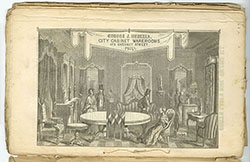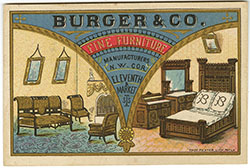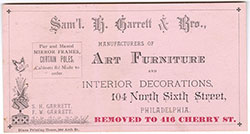 |
George Albert Lewis, The Old Houses and Stores With Memorabilia Relating to Them and My Father and Grandfather (Philadelphia, 1900). Gift of Oliver E. Allen. G. Albert Lewis (1829-1915) compiled his family history into an album, illustrating it with magnificent watercolors, photographs, and ephemera. Depicted here is the parlor of his parents’ home on South 2nd Street, where they lived from 1824 to 1840. He wrote that “the parlors of this house were very handsome-- the front being in red and yellow--with white and gold paint except the doors, while the ceiling was light blue.” Notice the Empire-style chairs, sofa, and the pier table with lion’s paw feet. [Catalog Record] |
||
 |
Anne C. Lewis, Memories of the Home of Grandma Lewis (Philadelphia, 1896). Gift of Oliver E. Allen. The Lewis family of Philadelphia cherished this mahogany pier table that was made for John F. Lewis (1791-1858) and later gifted to his son George on his marriage to Anne Larcombe (1831-1898) in 1851. Here it is shown in their home in the 1890s. Anne noted the matching Empire-style mahogany chairs “were its [the table] associated for many years, and still keeps company with it in our dining room.” [Catalog Record] |
||
 |
Désiré Guilmard, Le Garde-Meuble Ancien et Moderne (Paris, ca. 1848). Guilmard’s influential magazine Le Garde-Meuble Ancien et Moderne circulated widely. It consisted solely of illustrations in three categories: sièges (seated furniture); meubles (case furniture); and tentures (curtains and draperies). |
||
 |
Désiré Guilmard, Le Garde-Meuble Ancien et Moderne (Paris, ca. 1848). Bequest of James Rush, 1869. A French publisher of furnishings and interior decoration, Guilmard’s designs were readily copied, particularly by Philadelphia cabinetmaker George Henkels. His magazine showcased the latest in Parisian style, and a number of copied images also appeared in Godey’s magazine. |
||
 |
George J. Henkels, An Essay on Household Furniture (Philadelphia, ca. 1850). Philadelphia cabinetmaker George J. Henkels (1819-1883) ran a successful business influenced by the latest French fashion. A keen self-promoter, he publicized through pamphlets and articles, in addition to advertising in magazines and newspapers. |
||
 |
A. Kollner, lithographer, City Cabinet Warerooms (Philadelphia, ca. 1850). Lithograph. Henkels employed about 180 people at his 173 Chestnut Street business in two four-story buildings. Employees included turners, carvers, varnishers, seamstresses, upholsterers, clerks, bookkeepers, salesmen, and many others. [Catalog Record] |
||
 |
“George J. Henkels. City Cabinet Warerooms,” Godey’s Lady’s Book (Philadelphia, July 1850). By the mid-nineteenth century, technological advances in manufacturing combined with a growing middle class eager to acquire the accoutrements of refined living resulted in the selling of furnishings on a larger scale. Customers could shop in warerooms and view finished pieces on display. In the foreground, you can see Henkels’s patented extension dining table. So strong and firm are the extensions that Henkels claimed “a jig might be danced on the table.” [Catalog Record] |
||
 |
W.H. Rease, artist, George Mecke Cabinet Maker and Upholsterer (Philadelphia, 1846). Lithograph. The hustle and bustle of a busy wareroom is shown in this advertising print for Mecke’s business on Second Street. Customers browsed and shopped for furniture on the first floor, while the upper floors were reserved for manufacturing. Also available were horse-drawn delivery services. [Catalog Record] |
||
 |
Frederick Dreer’s Cabinet Ware Room (Philadelphia, after 1816). Frederick Dreer came from Hanover, Germany and settled in Philadelphia creating a successful cabinetmaking business. |
||
|
Assortment of Tradecards of Philadelphia Cabinetmakers (Philadelphia, 19th c.). |
|||
 |
 |
 |
 |
 |
 |
 |
|
 |
 |
 |
|
 |
 |
 |
|
 |
|||
 |
Devereux, artist. W.S. Sanderson & Son, Chair Warehouse (Philadelphia, 1857) as seen in McElroy’s Philadelphia Directory for 1857. Chairmaker William Sanderson and his son William, Jr. owned a chair warehouse on Walnut Street. Advertised are chairs in various styles including Gothic and classical. They also made sofas, settees, rocking chairs, and stools. |
||
 |
O.H. Hunter, lithographer. City Interiors (Philadelphia, 1880s). |
||
 |
Peck & Hills’ Furniture Co., 642 North Broad St. cor. Wallace, Philadelphia, Pa. (Philadelphia, ca. 1922). Photolithograph. Peck & Hills had warerooms in cities across the country, including Chicago, Los Angeles, New York, and Philadelphia, which is represented in this postcard showing an eclectic selection of furnishings. [Catalog Record] |
||
